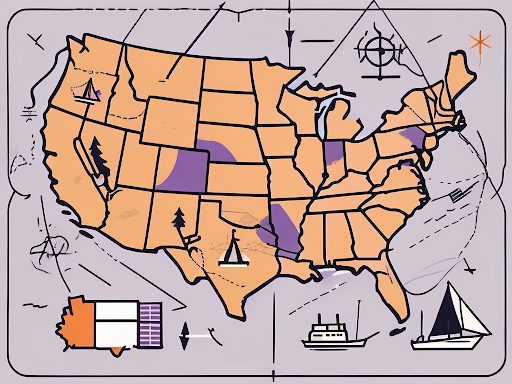Did you know that over 30% of Americans have shipped items to Canada at some point in their lives? Whether you’re wondering how to ship from the US to Canada or have done it before, the process is straightforward with the right information and preparation.
By following the correct steps, you can ensure a smooth and efficient process for sending your packages across the border.
This guide will walk you through the following:
- Essential steps to successfully ship items from the United States to Canada
- Importance of proper packaging and choosing the right carrier
- Preparation of your package for the shipment
- Navigation of your package and dealing with customs
Table of Contents
ToggleSimple Steps for Shipping from the US to Canada
Shipping from the US to Canada can be simple with the right steps. Whether it’s for personal or business purposes, this guide will help ensure your package arrives safely and on time.
1. Choose the Right Courier Service
The first step is selecting a reliable courier. Look for services that offer consistent delivery times, real-time tracking, and strong experience with cross-border shipping.
Popular couriers for US-to-Canada shipments include:
- FedEx, UPS, DHL, and USPS: These companies offer both standard and express shipping options.
- Real-time tracking: Make sure the courier provides tracking so you and the recipient can monitor the shipment.
2. Prepare Your Package Properly
Packing your items securely is essential to avoid damage during transit. Make sure your package is sturdy and properly sealed:
- Use strong boxes and padding: Secure fragile goods with bubble wrap or packing paper.
- Proper labeling: Include clear recipient and sender addresses on the package to avoid misdelivery.
- Seal the package well: Use durable tape to close all seams and protect the package during transit.
3. Complete the Necessary Customs Documentation
When shipping internationally, customs forms are required. For US-to-Canada shipments, ensure you:
- Accurately declare the contents: Clearly describe the items in your package.
- State the value: List the correct value of the goods for customs purposes.
- Check duty and tax regulations: Depending on the value of the package, Canada may impose duties or taxes.
Filling out customs forms correctly will prevent delays and ensure your shipment clears customs smoothly.
4. Calculate Shipping Costs and Track Your Shipment
Before shipping, calculate the costs based on the weight, size, and delivery speed. You can do this using the courier’s online calculator:
- Standard vs. Express Shipping: Decide whether you need a faster (and more expensive) option or if standard shipping will suffice.
- Track the package: Use the tracking number to monitor your shipment’s progress, and notify the recipient of any potential delays.
The Importance of Proper Packaging
When shipping items internationally, proper packaging is non-negotiable. An item poorly packed can lead to damage, delays, and in certain instances, returned packages.
Using the correct materials not only ensures safety but also compliance with carrier requirements.
To keep your shipment in pristine condition, always:
- Use strong, rigid boxes that can withstand handling.
- Employ cushioning materials such as bubble wrap or packing peanuts.
- Seal packages securely with high-quality tape.
Additionally, consider labeling your packages clearly and accurately.
This not only helps in the identification of the contents but also aids customs officials in processing your shipment more efficiently.
Including a detailed packing list inside the box can further facilitate this process, ensuring that all items are accounted for and reducing the likelihood of delays at customs.
Choosing the Right Shipping Carrier
The choice of shipping carrier matters significantly when sending goods to Canada. Major carriers like USPS, UPS, and FedEx each offer distinct advantages and may vary in terms of delivery speed, tracking capabilities, and price.
Consider the following factors when selecting a carrier:
- Delivery times: How quickly do you need your package to arrive?
- Cost: What’s your budget, and how does the price vary by carrier?
- Tracking: Is tracking necessary for your shipment for peace of mind?
Moreover, it’s wise to look into the customer service reputation of each carrier.
In the event of an issue, having a responsive support team can make a significant difference in resolving problems quickly.
Some carriers also offer additional services such as insurance for high-value items, which can provide extra peace of mind when shipping fragile or expensive goods.
Preparing Your Package for Shipment
Once you have grasped the essentials of international shipping, it’s time to prepare your package for shipment.
This involves more than just boxing up your items—it requires a strategic approach to ensure everything is compliant and secure.
Packaging Materials You’ll Need
You must gather specific materials to create a robust shipping environment. The right materials will protect your items during transit and help facilitate smooth customs processing. Ensure you have:
- Sturdy cardboard boxes of various sizes.
- Cushioning materials like bubble wrap or foam peanuts.
- Waterproof plastic wrap or bags, especially for delicate items.
- High-quality packing tape.
In addition to these essentials, consider investing in corner protectors for larger items or artwork, as they can help absorb shocks and prevent damage to edges and corners.
You may also want to have a pair of scissors and a marker handy for any last-minute adjustments or labeling needs. Remember, the more prepared you are, the smoother the packing process will be.
How to Pack Your Items Securely
Packing your items securely can make a world of difference in ensuring they arrive undamaged. Begin by wrapping fragile items individually before placing them in your box.
A pro tip: fill any empty spaces in the box with extra packing material to prevent movement during transit. The last thing you want is for your favorite ceramic mug to arrive in pieces!
For heavier items, place them at the bottom of the box and surround them with cushioning material to provide stability. Lighter items can be placed on top, but ensure they are also well-protected.
If you are shipping multiple items, consider creating compartments within the box using dividers made from cardboard or additional cushioning to keep everything organized and secure during transit.
Labeling Your Package Correctly
Labels are not just decorative; they are essential for the processing and delivery of your package. Ensure you include:
- The recipient’s name and complete address, including postal code.
- Your return address.
- A clear label indicating “International Shipment” to avoid confusion.
Additionally, it’s wise to include a packing slip inside the package that lists the contents and their values.
This not only aids customs clearance but also provides the recipient with a clear understanding of what to expect upon opening the package.
If your shipment contains items that may require special handling, such as perishables or hazardous materials, be sure to include appropriate labels that comply with international shipping regulations.
This attention to detail can significantly reduce the risk of delays or complications during transit.
Navigating the Shipping Process
With your package prepared and labeled correctly, it’s time to navigate the shipping process. This step can be seamless if you’re well-prepared and informed.
Selecting a Shipping Method
Different shipping methods can significantly alter delivery times and costs. Options generally include standard, expedited, and courier services.
Consider how urgent the shipment is when choosing a method.
For example, if you’re sending a birthday gift, expedited shipping may prevent any late arrivals, even if it is a touch pricier. Always weigh the pros and cons based on your needs!
Additionally, it’s wise to consider the reliability of the shipping provider. Some carriers may offer better tracking systems or customer service than others, which can be crucial if any issues arise during transit.
Researching reviews and asking for recommendations can help you select a shipping method that not only meets your budget but also provides peace of mind.
Filling Out the Necessary Paperwork
When shipping internationally, proper paperwork is crucial to avoid delays or returns. Here’s what to keep in mind:
- Customs Declaration Form: Accurately detail the contents, value, and purpose of the shipment to prevent customs clearance delay.
- Understand Restrictions: Some items may be restricted or require additional documentation. Knowing these regulations can save you from delays or additional complications.
Tracking Your Shipment
Keeping track of your shipment is easy with real-time tracking. Here’s how to make the most of it:
- Share the Tracking Number: Let your recipient know the tracking details so they can follow the package’s journey.
- Set Up Notifications: Enable email or text alerts for updates, including when the package is out for delivery.
Dealing with Customs When Shipping to Canada
Unfortunately, customs cannot be avoided when shipping internationally, but being well-informed can mitigate any issues that arise.
Understanding Duties and Taxes
When your package crosses the border, it may be subject to duties and taxes. These fees depend on the item’s value and classification. Understanding this aspect can prevent surprises for both the sender and receiver.
If you’re shipping gifts under CAD 60, you’re generally safe from duties, but ensure you’ve verified current regulations as they can change.
Additionally, it’s important to note that some items may be exempt from duties altogether, depending on trade agreements and specific exemptions in place.
For example, certain educational materials or personal effects might qualify for duty-free status, making it worthwhile to research the specifics of your shipment.
Required Customs Documentation
Customs documentation is crucial for a hassle-free experience. Depending on the nature of your shipment, you may need specific forms ready. Always keep in mind:
- Commercial invoices for items being sold.
- Complete declarations for gifts or personal items.
In addition to these documents, it’s wise to include a detailed description of the items being shipped, including their intended use and value.
This not only helps customs officials understand the nature of your shipment but also assists in the correct classification of your items, which can ultimately affect the duties and taxes applied.
Furthermore, using clear and concise language can prevent misunderstandings that may lead to delays.
Effortless Shipping from the US to Canada: Your Complete Guide
Shipping from the US to Canada doesn’t have to be complicated. By following the right steps—choosing a reliable courier, securely packing your items, completing customs paperwork accurately, and tracking your shipment—you can ensure a smooth delivery process.
Understanding the customs regulations, packaging essentials, and available shipping methods will save you time and prevent unnecessary delays.






